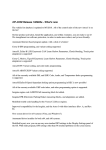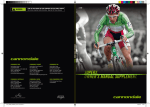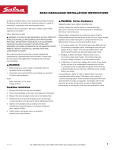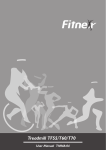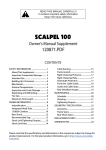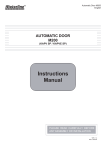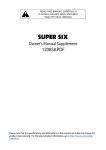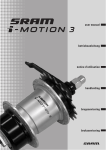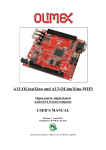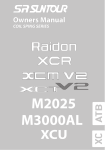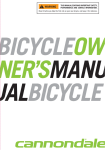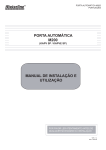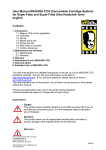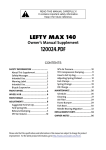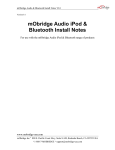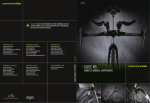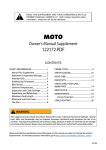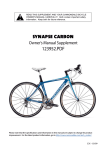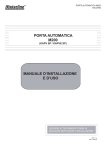Download ENGLISH 2 - 18 DEUTSCH 20 - 36 FRANCAIS 38
Transcript
F Owner’S Manual SUPPLEMENT 126709.PDF ENGLISH 2 - 18 DEUTSCH 20 - 36 FRANCAIS 38 - 54 ITALIANO 56 - 72 ESPANOL 74 - 90 NEDERLANDS 92- 108 In this supplement, particularly important information is presented in the following ways: WARNING NOTICE Indicates special precautions that must be taken to avoid damage. TIP A TIP provides helpful information. This manual meets EN standards 14764, 14766, and 14781. 2 Indicates a hazardous situation which, if not avoided, could result in death or serious injury. 126709.PDF SAFETY INFORMATION IMPORTANT COMPOSITES MESSAGE INSPECTION & CRASH DAMAGE OF CARBON FRAMES/FORKS WARNING AFTER A CRASH OR IMPACT: WARNING Your bike (frame and components) is made from composite materials also known as “carbon fiber.” All riders must understand a fundamental reality of composites. Composite materials constructed of carbon fibers are strong and light, but when crashed or overloaded, carbon fibers do not bend, they break. For your safety, as you own and use the bike, you must follow proper service, maintenance, and inspection of all the composites (frame, stem, fork, handlebar, seat post, etc.) Ask your Cannondale Dealer for help. We urge you to read PART II, Section D. “Inspect For Safety” in your Cannondale Bicycle Owner’s Manual BEFORE you ride. YOU CAN BE SEVERELY INJURED, PARALYZED OR KILLED IN AN ACCIDENT IF YOU IGNORE THIS MESSAGE. Inspect frame carefully for damage (See PART II, Section D. Inspect For Safety in your Cannondale Bicycle Owner’s Manual. ) Do not ride your bike if you see any sign of damage, such as broken, splintered, or delaminated carbon fiber. ANY OF THE FOLLOWING MAY INDICATE A DELAMINATION OR DAMAGE: An unusual or strange feel to the frame Carbon which has a soft feel or altered shape Creaking or other unexplained noises, Visible cracks, a white or milky color present in carbon fiber section Continuing to ride a damaged frame increases the chances of frame failure, with the possibility of injury or death of the rider. BICYCLE REPAIR / WORK STANDS The clamping jaws of a bike stand can generate a crushing force strong enough to seriously damage your frame. NOTICE Never place your bike in a bike stand by clamping the frame. Place your bike in a stand by extending the seat post and positioning the stand clamp on the extended seat post. Don’t extend beyond the MINIMUM INSERT line marked on the seat post. Since your carbon seat post can also be damaged by clamping force, adjust the stand clamp for the minimum clamping force needed to secure the bike. Also, before clamping, clean the post and protect the seat post finish with a rag. 3 INTENDED USE NOT INTENDED All models are intended for Condition 3 Cross-Country, Marathon) riding. Condition 3 symbol shown in next figure. For use in extreme forms of jumping/riding such as hardcore mountain, Freeriding, Downhill, North Shore, Dirt Jumping, Hucking etc. TRADE OFF Cross-Country bikes are lighter, faster to ride uphill, and more nimble than All-Mountain bikes. Cross-Country and Marathon bikes trade off some ruggedness for pedaling efficiency and uphill speed. For riding on unimproved trails with small obstacles CONDITION 3 Bikes designed for riding Conditions 1 and 2, plus rough trails, small obstacles, and smooth technical areas, including areas where momentary loss of tire contact with the ground may occur. NOT jumping. All mountain bikes without rear suspension are Condition 3, and so are some lightweight rear suspension models. INTENDED For cross-country riding and racing which ranges from mild to agressive over intermediate terrain (e.g., hilly with small obstacles like roots, rocks, loose surfaces and hard pack and depressions). There are no large “sick drop” or drop offs, jumps or launches (wooden structures, dirt embankments) requiring long suspension travel or heavy duty components. Crosscountry and marathon equipment (tires, shocks, frames, drive trains) are light-weight, favoring nimble speed over brute force. Suspension travel is relatively short since the bike is intended to move quickly on the ground and not spend time in the air landing hard and hammering through things. 4 MAXIMUM WEIGHT LIMIT RIDER lbs / kg LUGGAGE * lbs / kg TOTAL lbs / kg 300 / 136 5 / 2.3 305 / 138 * Seat Bag Only WARNING UNDERSTAND YOUR BIKE AND ITS INTENDED USE. USING YOUR BIKE THE WRONG WAY IS DANGEROUS. Industry usage Conditions 1 - 5 are generalized and evolving. Consult your Cannondale Dealer about how you intend to use your bike. Please read your Cannondale Bicycle Owner’s Manual for more information about Intended Use and Conditions 1-5. 126709.PDF MAXIMUM FORK LENGTH TIRE SIZE Maximum Fork Length is an important frame safety testing specification. You must observe the measurement when installing headset parts, headset adapters, installing and adjusting a fork, and selecting replacement forks. In this manual, the number is also listed in the GEOMETRY/SPECIFICATIONS. WARNING OBSERVE THE “MAXIMUM TIRE WIDTH” FOR YOUR BIKE FOUND IN THE GEOMETRY/ SPECIFICATIONS SECTION OF THIS SUPPLEMENT. Mounting the wrong size tires can result in the tires hitting the fork or frame when riding. If this happens, you can lose control of your bike and you can be thrown off, a moving tire can be stopped because it touches the fork or frame. HEADTUBE HEADSET PARTS or ADAPTERS MAXIMUM FORK LENGHT Do not mount oversized tires, ones that rub or hit the fork or frame, ones that result in too little clearance, or ones that can hit the fork or frame when the suspension is fully compressed or when riding. Take care that the tires you select are compatible with your bike’s fork or frame design. Also, be sure to follow the manufacturer’s recommendations of your front fork and rear shocks. When you are considering tires for your bike consider... AXLE HOW TO MEASURE: 1. Install headset and fork. 2. Extend fork and measure the distance from the bottom of the head tube to the center of the wheel axle. Do not measure from the bottom of headset bearing cups or head tube adapters. The measurement MUST be taken from the bottom of the head tube!! WARNING DO NOT EXCEED MAXIMUM FORK LENGTH Exceeding the MAXIMUM FORK LENGTH limit can overload the frame causing it to fail (break) while riding. YOU CAN BE SEVERELY INJURED, PARALYZED OR KILLED IN AN ACCIDENT IF YOU IGNORE THIS WARNING. The actual measured size of a tire may be different than its sidewall marking. Each time you mount a new tire, take the time to inspect the actual clearance between the rotating tire and all parts of the frame. The U.S. Consumer Product Safety Commission (CPSC) requires at least 1/16” (1.6 mm) tire clearance from any part of the bike. Allowing for lateral rim flex and a wheel or rim that is out-of-true will likely mean choosing a rear tire that provides even more clearance than the CPSC recommends. ASK YOUR CANNONDALE DEALER FOR THE RIGHT TIRES FOR YOUR BIKE AND ITS PARTICULAR COMPONENTS! YOU CAN BE SEVERELY INJURED, PARALYZED OR KILLED IN AN ACCIDENT IF YOU IGNORE THIS WARNING. 5 F CarBOn SeaT POST Installation MInIMuM SeaT POST InSerT DePTH 1. Always clean the inside of the seat tube with a dry clean shop towel. For carbon frames, the seat post must be inserted a minimum of 90 mm or 3.5 inches 2. Apply a generous amount carbon gel to the inside of the clean seat tube and to the seat post. A small nylon brush works well for spreading inside the seat tube. 90 mm warnInG MaKe Sure aT leaST 90 mm OF THe SeaT POST IS InSerTeD InTO THe FraMe aT all TIMeS. Failure to insert the seat post correctly can place a very high stress on the seat tube top tube junction causing the frame to break while riding. Measure 90 mm from the bottom of the seat post. Use a permanent marker to mark the post at 90 mm. When adjusting the seat post height in the seat tube, never adjust the seat post so that the line you mark is above the top edge of the seat tube. YOu MuST alSO Be aware THaT bicycle seat posts are permanently marked by the manufacturer with a “MINIMUM INSERT” line on the seat post itself. You must not rely on this marking as an indication of the proper MINIMUM SEAT POST INSERTION DEPTH. YOu Can Be SeVerelY InJureD, ParalYZeD Or KIlleD In an aCCIDenT IF YOu IGnOre THIS warnInG. 6 3. Apply small amount of bicycle bearing grease to the area under the binder on the seat tube. Reinstall the seat binder. Be sure to align the binder pin with the seat tube slot. SEAT BINDER Pin ALIGN Slot 5 nm, 44 Inlbs Carbon gel Light grease 126709.PDF 4. Insert the seat post, set saddle height, and tighten the binder bolt to 5 Nm, 44 In Lbs. nOTICe neVer uSe SOlVenTS Or SPraY CleanerS. DOn’T uSe GreaSe; alwaYS uSe CarBOn Gel. Cannondale in kit KF115/ is a small quantity, enough for two or three applications. neVer FOrCe THe SeaT POST InTO THe FraMe. Stop inserting the seat post before SaVe feature. See “MaX. InSerT” on page 7. alwaYS uSe a TOrQue wrenCH. TIP: When tightening the seat binder, also check the specified tightening torques of the saddle to seat post clamp bolts. TIP: Its a good idea to periodically remove the binder bolt, from the binder, clean it threads and lightly grease the threads. Cutting the Seat Post when cutting the seat post 1. Make a straight cut; use a cutting guide such as Park Tool SG-7 and a carbon specific saw blade. Lightly round and smooth the finished cut with fine sandpaper. 2. Re-mark the MINIMUM INSERT line 90 mm up from the bottom of the cut seat post. Mark the seat post without scoring, scratching or otherwise damaging the surface of the seat post. Use a thin decal (automotive pin striping) or a paint marker. NOTE: U.S. Consumer Product Safety Commission (CPSC) bicycle regulations require minimum seat post insertion be marked on the seat post warnInG If the seat post requires cutting, have it done by a professional bike mechanic with experience cutting highperformance carbon components. YOu Can Be SeVerelY InJureD, ParalYZeD Or KIlleD IF YOur IGnOre THIS warnInG. More Information on Carbon Seat Posts For more information about carbon fiber seat posts, see also “APPENDIX C. Care and Maintenance of Carbon Fiber Seat Posts” in your Cannondale Bicycle Owner’s Manual. 7 Replacement Cannondale part numbers are shown throughout this supplement in BOLD ITALIC text. GEOMETRY /SPECIFICATION B G C A F D E M J K L I H N F CARBON Size A B C D E F G H I J K L M N Specifications SEAT TUBE LENGTH (CM/IN) TOP TUBE HORIZONTAL (CM/IN) TOP TUBE ACTUAL (CM/IN) HEAD TUBE ANGLE SEAT TUBE ANGLE STAND OVER (CM/IN) HEAD TUBE LENGTH - (CM/IN) WHEELBASE (CM/IN) FRONT CENTER (CM/IN) CHAIN STAY LENGTH (CM/IN) BOTTOM BRACKET DROP (CM/IN) BOTTOM BRACKET HEIGHT (CM/IN) FORK RAKE (CM/IN) TRAIL (CM/IN) INTENDED USE MAXIMUM FORK LENGTH (mm) SEAT POST DIAMETER MINIMUM SEATPOST INSERT FRONT DERAILLEUR HEADTUBE BOTTOM BRACKET CHAINLINE DROPOUT SPACING REAR BRAKE BRAKE ROTOR MAXIMUM TIRE WIDTH F carbon 29’er Small Medium Large X-Large Medium Large 38.2/15 43.2/17 48.2/19 53.2/20.9 43.0/16.9 47.5/18.7 55.5/21.9 58.5/23 61.5/24.2 64.0/25.2 59.3/23.3 62.2/24.5 54.8/21.6 56.6/22.3 59.1/23.3 61.8/24.3 57.3/22.6 59.6/23.5 69.8° 70.1° 70.3° 70.5° 71.0° 71.2° 73.9° 73.6° 73.3° 73.0° 73.5° 73.0° 75.2/29.6 77.5/30.5 79.9/31.5 82.0/32.3 79.8/31.4 81.9/32.2 13.4/5.3 * * * 13.4/5.3 * 105.8/41.7 108.1/42.6 110.6/43.5 112.5/44.3 109.8/43.2 110.9/43.7 63.8/25.1 66.2/26.1 68.6/27 70.5/27.8 66.2/26.1 67.3/26.5 42.2/16.6 * * * 44.4/17.5 44.4/17.5 3.5/1.4 * * * 6.5/2.6 * 29.5/11.6 * * * 30.2/11.9 * 4.5/1.8 * * * 4.5/1.8 * 7.3/2.9 7.2/2.8 7.0/2.8 6.9/2.7 7.9/3.1 7.7/3 CONDITION 3, XC RACING 500 27.2 mm 90 mm Direct Mount Headshok, 1.5”, 1.125 “ BB30 only 50 mm 135 mm POST MOUNT 140 mm, 160 w/adapter 26 X 2.25 in 29 X 2.25 in MAXIMUM WEIGHT LIMIT (lbs/kg) * (seat bag only) RIDER LUGGAGE* TOTAL 300 / 136 5 / 2.3 305 / 138 Please note that the specifications and information in this manual are subject to change for product improvement. For the latest product information, go to http://www.cannondale.com/tech_center/ 8 X-Large 52.5/20.7 64.1/25.3 61.3/24.1 71.4° 72.5° 84.0/33.1 * 112.0/44.1 68.4/26.9 44.4/17.5 * * * 7.6/3 126709.PDF 10 - 12 nm, 89 - 106 Inlbs INTEGRATED HEAD TUBE SEAT BINDERS KP120/BLK KP120/GRN The seat post is larger than 27.2 mm starting here up. TOP TUBE 5 nm, 44 Inlbs MAX. INSERT MIN. INSERT MINIMUM SEAT POST INSERT 90 mm SEATSTAY SEAT POSTS KP124/GRN KP124/RED KP124/WHT DOWNTUBE SEAT TUBE 160 mm ROTOR ADAPTERS KP135/ - SRAM SCUFFGUARDS - KF103/ DROPOUT 1.1 nm. 10 Inlbs Loctite 242 (blue) FD NIPPLE REAR BRAKE POST MOUNT DOWNTUBE PROTECTOR KP054/ 10 nm, 89 Inlbs MaX. TOrQue FD MOUNT RD HANGER KP121/ m 26 x 13 m 9) (code 3 of CHAINSTAY BB30 SHELL CHAINSTAY PLATE KP125/ KB6180/ 5-DIGIT SEQUENCE IN YEAR FACILITY CODE YEAR CODE FRAME SERIAL NUMBER LOCATION (7-character barcode label) BB CABLE GUIDE KP122/ (includes FD NIPPLE) KP123/ CHAINPLATE Use this serial number for warranty registration and theft recovery. See your Cannondale Bicycle Owner’s Manual for more information on warranty registration. 9 B G C A F D E M J K I L H N F allOY Size a B C D e F G H I J K l M n SPeCIFICaTIOnS SEAT TUBE LENGTH (CM/IN) TOP TUBE HORIZONTAL (CM/IN) TOP TUBE ACTUAL (CM/IN) HEAD TUBE ANGLE SEAT TUBE ANGLE STAND OVER (CM/IN) HEAD TUBE LENGTH - (CM/IN) WHEELBASE (CM/IN) FRONT CENTER (CM/IN) CHAIN STAY LENGTH (CM/IN) BOTTOM BRACKET DROP (CM/IN) BOTTOM BRACKET HEIGHT (CM/IN) FORK RAKE (CM/IN) TRAIL (CM/IN) INTENDED USE MAXIMUM FORK LENGTH (mm) SEAT POST DIAMETER FRONT DERAILLEUR HEADTUBE BOTTOM BRACKET CHAINLINE DROPOUT SPACING REAR BRAKE MAXIMUM TIRE WIDTH F allOY 29’er Small Medium large 38.0/15 43.3/17 47.5/18.7 55.0/21.7 58.4/23 61.4/24.2 54.1/21.3 56.4/22.2 58.8/23.1 70.0° 70.0° 70.0° 73.5° 73.5° 73.0° 74.9/29.5 77.5/30.5 79.4/31.3 13.4/5.3 13.4/5.3 13.4/5.3 104.7/41.2 108.2/42.6 110.6/43.5 62.6/24.6 66.0/26 68.4/26.9 42.4/16.7 42.4/16.7 42.4/16.7 3.5/1.4 3.5/1.4 3.5/1.4 29.0/11.4 29.0/11.4 29.0/11.4 4.5/1.8 4.5/1.8 4.5/1.8 7.0/2.8 7.0/2.8 7.0/2.8 Medium 43.3/17 59.3/23.3 57.7/22.7 71.0° 73.5° 80.7/31.8 13.4/5.3 108.8/42.8 65.2/25.7 44.4/17.5 6.5/2.6 30.5/12 4.5/1.8 8.0/3.1 CONDITION 3, XC RACING 500 31.6 mm 34.9mm Headshok, 1.5”, 1.125 “ BB30, 68 mm w/adapter 50 mm 135 mm INTERNATIONAL STANDARD 26 X 2.25 in MAXIMUM WEIGHT LIMIT (lbs/kg) * (seat bag only) 10 X-large 52.5/20.7 62.9/24.8 60.3/23.7 70.0° 72.5° 83.0/32.7 16.0/6.3 111.7/44 69.5/27.4 42.4/16.7 3.5/1.4 29.0/11.4 4.5/1.8 7.0/2.8 large 47.5/18.7 62.2/24.5 59.7/23.5 * 73.0° 82.6/32.5 13.4/5.3 111.1/43.7 67.5/26.6 * * * * * X-large 52.5/20.7 63.9/25.2 61.1/24.1 * 72.5° 85.0/33.5 13.4/5.3 112.2/44.2 68.6/27 * * * * * CONDITION 3, XC RACING 500 31.6 mm 34.9 mm Headshok, 1.5” , 1.125” BB30, 68 mm w/adapter 50 mm 135 mm INTERNATIONAL STANDARD 29 X 2.25 in RIDER LUGGAGE* TOTAL 300 / 136 5 / 2.3 305 / 138 126709.PDF INTEGRATED HEAD TUBE TOP TUBE SEATSTAY SEAT TUBE DROPOUT DOWNTUBE REAR BRAKE IS MOUNT 1.1 nm. 10 Inlbs Loctite 242 (blue) RD HANGER KP121/ (MY2011) KP048/ (MY2010) KP009/ m 26 x 13 m 9) (code 3 of BB30 SHELL CHAINSTAY 6-DIGIT SEQUENCE IN YEAR YEAR CODE SCUFFGUARDS - KF103/ KB6180/ QC616/ FRAME SERIAL NUMBER LOCATION (7-character barcode label) BB CABLE GUIDE KF363/ 11 Integrated Head Tube In both alloy and carbon frame models, the SI bearing cups are intergrated within the head tube. In alloy frames, the cups are machined in the head tube. In carbon models, cups are permanently bonded into the head tube. Cannondale Headshok System Integration bearings are accepted directly into both type. The following headset kits are available through your Cannondale Dealer: HEADSHOK QSISEAL/ UPPER BEARING SEAL 58MM OD HD169/ SI HEADSET BEARINGS 1,5” 1.125” 45° UP 45° DOWN KP119/ HEADSHOK TO 1.5” - or - 12 mm KP058/ HEADSHOK TO 1 1/8” NOTICE CARBON OR ALLOY: Do not face, surface, or cut the head tube bearing cups. CARBON : When removing adapters, bearings, or cup from the carbon head , extra care must be used so that the tool used to drive out the bearing is NOT located on any part of the bonded cup. 12 126709.PDF bottom bracket Both F CARBON and F ALLOY frames are compatible with the BB30 Standard. See http://www.bb30standard.com/ Integrated Circlip Groove BEARING KB6180/ F CARBON bottom bracket shells are manufactured with integrated circlips. F CARBON bottom bracket shells not compatible with the 68 mm adapter. CIRCLIP BEARING QC616/ KB6180/ F ALLOY bottom bracket shells use circlips. F ALLOY The bottom bracket shell of these frames is compatible with the Cannondale 68 mm adapter. See page 8. BEARING MAINTENANCE Inspect bearing condition annually (at a minimum) and anytime the crankset assembly is disassembled or serviced. With the crankset removed, rotate the inner bearing race of both bearings; rotation should be smooth quietly. No bearing play or movement inside the shell. If the bearing is damaged, replace both bearings with new ones. 13 BEARING INSTALLATION 1. Clean the inside and outside surfaces of the bottom bracket shell. BEARING 2. Apply a high-quality bicycle bearing grease to the inside surface of the shell. 3. Install the square end of the circlip into the groove first, then moving clockwise, push the clip into the groove until it is fully seated in the groove. Install the other circlip the same way. KT010/ BEARING INSTALLATION TOOL 4. With a headset press, and Cannondale tool KT010/ install the bearings into the shell as shown. Press the bearing until it is seated against the circlip. 5. To finish, apply a light coating of a high-quality bicycle bearing grease to both sides of each bearing to help repel moisture. BEARING REMOVAL 1. To remove the bearings, position Cannondale tool KT011/ behind the bearing so that the tool ridges are seated on the bearing. See next page. 2. Insert a driver (punch or drift) from the opposite side. Locate it on the back of the tool and use light tapping to drive the bearing from the shell. NOTICE BEARING KT011/ BEARING DRIVER Frequent or routine renewal of undamaged bearings is not recommended. Repeated removal and reinstallation can damage the inside BB shell surfaces resulting in poor bearing fit. DO NOT FACE, MILL OR MACHINE THE BOTTOM BRACKET SHELL FOR ANY REASON. Doing so can result in serious damage and possibly a ruined bike frame. 14 TIP: Unless a circlip is damaged, removal is unnecessary during bearing removal . Use a small thin-blade screw driver or pick to lift the hooked end up out of the groove and then pushing the circlip out counter-clockwise. Thin blade screw driver to lift hooked out of BB groove 126709.PDF 68 mm ADAPTER INSTALLATION The following procedure should only be completed by a professional bike mechanic. The adapter IS NOT a repair part and will only work in undamaged frames in good condition. 1. Remove the BB30 bearings and circlips from the bottom bracket shell. 2. Thoroughly clean and dry the inside of the bottom bracket shell. Remove any grease or dirt. Use a clean lint-free shop towel dampened with alcohol to finish. 3. Apply Loctite™ 609 carefully to the bearing seat positions on both side of the inside shell. 4. Clean the outer surface of the adapter. Use a clean shop towel dampened with alcohol. 5. The groove side of the adapter must be located on the drive side. With a headset press, press the ADAPTER until the groove side face is flush with the drive side face of the SI BB shell. Allow at least 12 hours (at 72°F) for the Loctite to cure before installing the standard bottom bracket crankset. Follow Loctite Technical Data Sheet http://tds.loctite.com/tds5/docs/609-EN.PDF Loctite™ 609 KP009/ 68 mm ADAPTER KF365/ ADAPTER w/TOOL (Headset press not shown) DRIVE SIDE NOTICE We strongly recommended that you use a swab to control the application and avoid spillage of the Loctite. Prolonged contact with the frame finish may result in discoloration or damage. Be sure to immediately wipe up any spills and remove any compound in contact with the painted surfaces. 15 68mm ADAPTER REMOVAL The following procedure should only be completed by a professional bike mechanic. The adapter is removable, however, repeated removal and reinstallation could result in damage to the SI BB shell and is not recommended. 1. Removal of the SI BB ADAPTER is accomplished through the use of the extraction tool KF366/ , a two-piece tool set used with a headset bearing press. The arrangement of the tool parts for removal is shown next figure. 2. Press the adapter out of the shell using the headset press until the adapter is retained inside the receiver and can be withdrawn from the bottom bracket shell. Following removal, it will be necessary to clean all remaining Loctite residue with a before reinstalling the SI circlips and bearings. Use Loctite 768. Use a dental pick to remove any adhesive from the grooves. Do not cut, face, or use abrasives to clean the inside if the BB shell. For Loctite clean-up instructions : http://tds.loctite.com/ ADAPTER Receiver Press KF366/ EXTRACTIONTOOL DRIVE SIDE (Headset press not shown) (Headset press not shown) NOTICE Use only extraction tool Cannondale KF366/ and a headset press. Do not use other tools. Make sure the Reciever part of the tool is centered on the drive side bottom bracket shell while pressing. We strongly recommend that your have this procedure performed by an Authorized Cannondale Dealer. Damage caused by improper removal is not covered under your warranty. 16 126709.PDF 160 MM aDaPTer (CarBOn) rear DeraIlleur HanGer Two Cannondale designed post mount adapters enable installation of 160 mm brake rotors. Before re- installing (same or new): Clean dropout and inspect carefully for any cracks or damage. Clean surfaces and apply a light film of bike grease to the dropout to minimize any noise or “creaking” that might result from very slight movement between the dropout and hanger during movement of the derailleur. Apply grease and Loctite carefully. Do not contaminate the male or female bolt threads with grease which would cause the Loctite to be ineffective. KP135/ - SRAM 160 MM 2.5 mm 1.1 N•m, 10 In•Lbs Loctite 242 (blue) KP121/ FrOnT DeraIlleur SraM S2 FD KP048/ KP123/ CHAINPLATE SraM S3 / SHIManO e-TYPe w/o plate FD FD Check derailleur adjustment after replacement. Readjust wheel quick release so it is very tight. See PART I Section 4. A in your Cannondale Bicycle Owner’s Manual. nOTICe Do not use a derailleur hanger alignment tool to straighten. If bending adjustment is necessary, remove the hanger from the frame first. 17 MAINTENANCE The following table lists only supplemental maintenance items. Please consult your Cannondale Bicycle Owner’s Manual for more information on basic bike maintenance. Consult with your Cannondale Dealer to create a complete maintenance program for your riding style, components, and conditions of use. Follow the maintenance recommendations given by the component manufacturers for the various non-Cannondale parts of your bike. WHAT TO DO HOW OFTEN APPLY FRAME PROTECTION: DOWNTUBE - A clear protective material is applied to carbon version of this bike. The material protects the downtube from damage caused by small debris. Have it replaced if it becomes damaged or is missing. See page 7. CHAINPLATE - Check the chain plate located on the drive side chainstay behind the chainrings. Replace it with a new one if it is missing or damaged. See page 7. HOUSING AND CABLES - Your bike has been supplied with small adhesive frame protectors. Place this material on the the frame between where cables and housing rub due to movement. Overtime, cable rubbing can wear into the frame itself causing very serious frame damage. See pages 7 and 9. AFTER FIRST RIDE & EVERY FEW RIDES CHAINSTAY - A clear adhesive chain slap protector has been placed on the right chainstay of the swingarm. Replace this protector if it becomes damaged. See pages 7 and 9. NOTE: Damage to your bike caused by cable rubbing is not a condition covered under your warranty. Also, adhesive frame guards are not a fix for incorrectly installed or routed cables or lines. If you find that applied guards are wearing out very quickly, consult with your Cannondale Dealer about the routing on your bike. INSPECT THE FRAME, CHAINSTSAY, SEATSTAYS - Clean and visually inspect entire bike frame/ assembly for cracks or damage. BEFORE AND AFTER EACH RIDE See “Inspect For Safety” in your Cannondale Bicycle Owner’s Manual. WARNING ANY PART OF A POORLY MAINTAINED BIKE CAN BREAK OR MALFUNCTION LEADING TO AN ACCIDENT WHERE YOU CAN BE KILLED, SEVERELY INJURED OR PARALYZED. Please ask your Cannondale Dealer to help you develop a complete maintenance program, a program which includes a list of the parts on your bike for YOU to check regularly. Frequent checks are necessary to identify the problems that can lead to an accident. 18


















